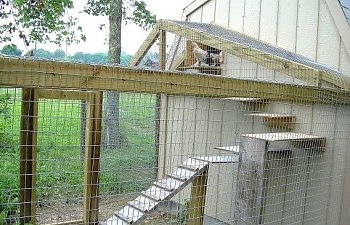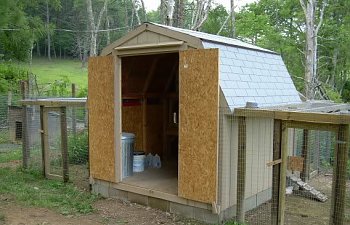Jeanne's Bantam Coop
When we moved to West Virginia from Massachusetts three years ago, my husband and I decided we wanted to raise some bantam chickens in addition to our laying flock. I had bantams in Massachusetts and didn't care for the coop we had built there. It was about 12 by 6 feet and was divided into four 3 foot by 6 foot rooms. I had different breeds of bantams and wanted to keep them separated.
This time, I wanted room to store the feed and other supplies in the coop and I didn't want to have to go outside to enter each separate room in the coop. It occurred to me that the six feet of headroom in a coop is for people, not the birds. They are pretty short and don't need more than a couple of feet.
My husband built an 8 by 8 foot barn type shed on a cement block foundation. I had him put two 2 foot deep shelves across the back. This made three separate rooms, counting the floor under them. The shelves are made from plywood, 2x6s and 2x4s. The entire front of each shelf is covered by a wire door (1" by 2" cage wire) hinged at the bottom except for the floor level which hinges up. It can be raised and hooked up out of the way for cleaning. The top two doors open down for cleaning.
For feeding and watering and egg gathering, there are two wire doors in each big door. The roosts are made from short pieces of 2X6 nailed on the short side to a piece of siding. This keeps them from tipping and they are removable for cleaning. I use small hanging feeders that can also be easily removed.
Feed and other supplies are stored in the front part of the coop.

This is the front of the coop. There are no windows but the front doors are kept open. There is a door made of 1x2 rabbit wire and 2x4s that completely covers the door opening when it is closed. It is opened inside in this picture. The wooden doors are closed only in very cold or inclement weather and we have drilled holes in either side of the building to provide ventilation.

This is the inside of the coop. The entire front of the lower level will swing upward for cleaning and each level has a small wire door at each end of the wire fronts for feeding, watering and egg gathering.
Having the chickens on three different levels meant that their access doors to the pens would. in the case of the two upper levels, be located high on the side of the building. We solved that problem with a series of steps and ramps.
The first level has just an ordinary ramp.

The second level needed stairs and a ramp.

The third level (the penthouse) has a longer ramp and more stairs. The access door for the chickens was so high, it was above the top of the pen which is wire covered, so we had to build that end of the pen top up so the chickens would not be coming out their door onto the top of the wire.

When we moved to West Virginia from Massachusetts three years ago, my husband and I decided we wanted to raise some bantam chickens in addition to our laying flock. I had bantams in Massachusetts and didn't care for the coop we had built there. It was about 12 by 6 feet and was divided into four 3 foot by 6 foot rooms. I had different breeds of bantams and wanted to keep them separated.
This time, I wanted room to store the feed and other supplies in the coop and I didn't want to have to go outside to enter each separate room in the coop. It occurred to me that the six feet of headroom in a coop is for people, not the birds. They are pretty short and don't need more than a couple of feet.
My husband built an 8 by 8 foot barn type shed on a cement block foundation. I had him put two 2 foot deep shelves across the back. This made three separate rooms, counting the floor under them. The shelves are made from plywood, 2x6s and 2x4s. The entire front of each shelf is covered by a wire door (1" by 2" cage wire) hinged at the bottom except for the floor level which hinges up. It can be raised and hooked up out of the way for cleaning. The top two doors open down for cleaning.
For feeding and watering and egg gathering, there are two wire doors in each big door. The roosts are made from short pieces of 2X6 nailed on the short side to a piece of siding. This keeps them from tipping and they are removable for cleaning. I use small hanging feeders that can also be easily removed.
Feed and other supplies are stored in the front part of the coop.
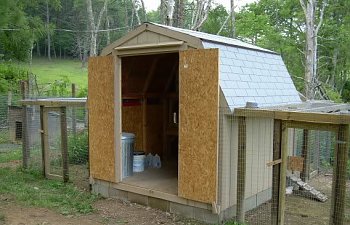
This is the front of the coop. There are no windows but the front doors are kept open. There is a door made of 1x2 rabbit wire and 2x4s that completely covers the door opening when it is closed. It is opened inside in this picture. The wooden doors are closed only in very cold or inclement weather and we have drilled holes in either side of the building to provide ventilation.
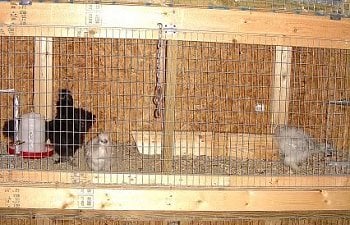
This is the inside of the coop. The entire front of the lower level will swing upward for cleaning and each level has a small wire door at each end of the wire fronts for feeding, watering and egg gathering.
Having the chickens on three different levels meant that their access doors to the pens would. in the case of the two upper levels, be located high on the side of the building. We solved that problem with a series of steps and ramps.
The first level has just an ordinary ramp.
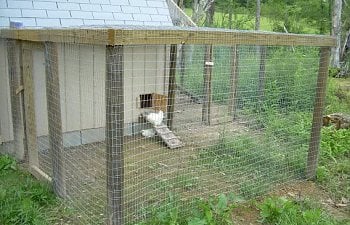
The second level needed stairs and a ramp.
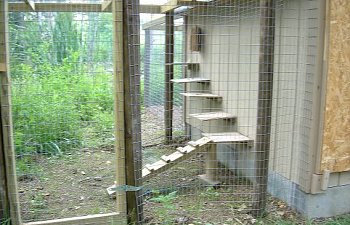
The third level (the penthouse) has a longer ramp and more stairs. The access door for the chickens was so high, it was above the top of the pen which is wire covered, so we had to build that end of the pen top up so the chickens would not be coming out their door onto the top of the wire.
